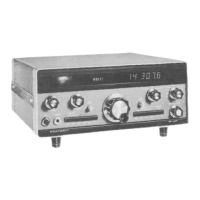LgS&=*=-*:*:.*m
Page 31 1
CIRCUIT DESCRIPTION
These circuits provide 3.395
MHz
IF amplification and gain
voltage which is fed through emitter follower
0512 to the
control, detection, and audio amplification.
front panel meter. Q511
is
a DC amplifier which derives the
In the receive mode, a 3.395
MHz
signal from
board
E
(the
crystal filter board) is fed to gate 1 of the dual
gate
MOSFET, 0501. The signal is amplified and passes to IC501
and
Q502 where additional amplification is obtained.
Emitter follower
0503 provides the power gain required to
drive the product detector, automatic gain control
(AGC)
circuits, and the 50 ohm IF output.
The IF output level is sensed by a differential amplifier.
Q504 and Q505. When the output lwel exceeds the
threshold
level, Q504 conducts and pulls the base of 0506
down on each positive peak of the IF output. '2506
conducts on each peak and places positive pulses on the base
of
0507.
Q507
is
an integrator which converts the pulses to
a
DC
voltage.
It
has two time constants which
set
the attack and
decay times for the AGC. R544 and C535
set
the attack
time constant and C535 discharges through either R546 or
R545 and
R546, depending on whether Fast or Slow
is
selected to
set
the decay time constant. This voltage, whose
level
is
a function of the !F output level,
is
fed through the
Dar\ington emitter follower, 0508 and Q509, where
it
is
then applied to pin 5 of
IC501 through R507 and D504.
The gain of the integrated circuit
is
thus controlled so that
the output remains relatively constant for varying input
levels.
The AGC voltage is also used to drive the Smeter drive.
Zener diode
ZD502 and R534
set
the range for S-meter
AGC voltage for the dual-gate MOSFET. With increasiw
signal level, the voltage at 0509 emitter rises from
approximately 4.5 to 7.0 volts. Given this input, Q511
provides (at the junction of
R541 and R538) a level of from
2.0 volts to zero volts with
inciasing input signal. Amplified
AGC voltage is applied to gate
2
of the first IF amplifier,
Q501.
The IF signal
is
detected by
a
product detector formed by
transformer
T502 and diodes D506 through D509. Carrier
injection through
C522 mixes with the IF signal to produce
the detected audio. After the IF
is
filtered out by R522.
C523, and C524, the recovered audio goes to the audio
bandpass filter and preamplifier. Both of these functions are
accomplished in
IC502, an integrated circuit made up of
four operational amplifiers. The first amplifier, pins 10, 11,
and 12,
is
used
as
a
low pass filter. Amplifier two, pins 2, 3,
and 4,
is
an audio amplifier. Amplifier three, pins 8. 9, and
13,
is
used as a high pass filter which, in cascade with the
low-pass filter,
sets
the audio frequency response. The
Volume control, between amplifiers three and four,
sets
the
desired audio level from the front panel. After additional
amplification by amplifier four (pins 1, 5, and 61, the audio
signal
is
fed through 13582 and C529 to the base of Q514.
Amplifier Q514 drives a complimentary output consisting of
Q515, Q516. 0517, and 0518. The audio output to the
speaker is taken from the collector of Q516 through
C531.
The frequency response of the audio amplifier
is
established
by a feedback circuit consisting of
Q513, C526, R526,
R527, and C528.

